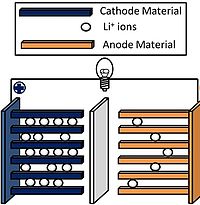
Photo from wikipedia
Lithium-rich manganese-based layered cathode materials are considered to be one of the best options for next-generation lithium-ion batteries, owing to their ultra-high specific capacity (>250 mAh·g−1) and platform voltage. However,… Click to show full abstract
Lithium-rich manganese-based layered cathode materials are considered to be one of the best options for next-generation lithium-ion batteries, owing to their ultra-high specific capacity (>250 mAh·g−1) and platform voltage. However, their poor cycling stability, caused by the release of lattice oxygen as well as the electrode/electrolyte side reactions accompanying complex phase transformation, makes it difficult to use this material in practical applications. In this work, we suggest a molybdenum surface modification strategy to improve the electrochemical performance of Li1.2Mn0.54Ni0.13Co0.13O2. The Mo-modified Li1.2Mn0.54Ni0.13Co0.13O2 material exhibits an enhanced discharge specific capacity of up to 290.5 mAh·g−1 (20 mA·g−1) and a capacity retention rate of 82% (300 cycles at 200 mA·g−1), compared with 261.2 mAh·g−1 and a 70% retention rate for the material without Mo modification. The significantly enhanced performance of the modified material can be ascribed to the formation of a Mo-compound-involved nanolayer on the surface of the materials, which effectively lessens the electrolyte corrosion of the cathode, as well as the activation of Mo6+ towards Ni2+/Ni4+ redox couples and the pre-activation of a Mo compound. This study offers a facile and effective strategy to address the poor cyclability of lithium-rich manganese-based layered cathode materials.
Journal Title: Molecules
Year Published: 2022
Link to full text (if available)
Share on Social Media: Sign Up to like & get
recommendations!